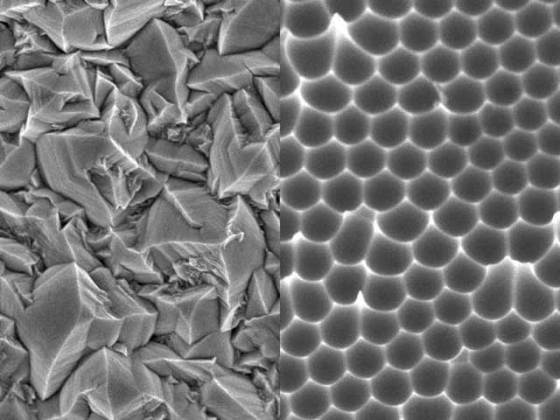Zinc oxide moulding enables production of thinner and cheaper solar cells
 Even though silicon is one of the most abundant elements, the energy required to make silicon from sand is immense. A group of researchers from the Swiss Federal Institute of Technology in Lausanne (EPFL) developed a new nanopatterning technique which boosts the output of the cells, thus enabling manufacture of solar cells that are one thousand times thinner than conventional cells.
Even though silicon is one of the most abundant elements, the energy required to make silicon from sand is immense. A group of researchers from the Swiss Federal Institute of Technology in Lausanne (EPFL) developed a new nanopatterning technique which boosts the output of the cells, thus enabling manufacture of solar cells that are one thousand times thinner than conventional cells.
Professor Christophe Ballif and his team from the Photovoltaics and Thin-Film Electronics Laboratory at the EPFL have been working for several years on thin-film silicon solar cells that are a thousand times thinner than conventional cells. However, the thinner the cells, the less they absorb the rays of the sun and the less electricity they produce.
Traditionally, thin layers of zinc oxide are used to trap light in the thin silicon layers to increase their absorption. Zinc oxide is a completely non-toxic and abundant material which grows in the form of small pyramid-shaped crystals. These crystals are used to scatter light efficiently into the underlying silicon layer. A new world record solar cell efficiency was achieved with such zinc oxide layers, but the researchers are trying to beat this record.
“It is difficult to modify the natural pyramidal shape of these crystals in order to obtain even better light scattering, so we had the idea to force the crystals to grow on a different support, an inverted mould with the desired structure”, said Corsin Battaglia, a researcher from the EPFL’s Photovoltaics and Thin Film Electronics Laboratory.
Once the thin layer of zinc oxide is deposited on the mould all that needs to be done is to “demould” it to obtain a film with the desired structure. The simplicity of the process makes it suitable for mass production.
Aside increasing the amount of light that is trapped, thereby increasing the power output as well, it also has the potential to reduce the cost of the solar cells due to lower cost of materials and energy needed to produce them.
For more information, read the article published in the journal Nature Photonics named: “Nanomoulding of transparent zinc oxide electrodes for efficient light trapping in solar cells”.










Good to know about nanopatterning technique which boosts the output of the cells from researchers from the Swiss Federal Institute of Technology in Lausanne (EPFL). It will help to have cheaper solar cells in the future.
Dr.A.Jagadeesh Nellore(AP),India
E-mail: anumakonda.jagadeesh@gmail.com